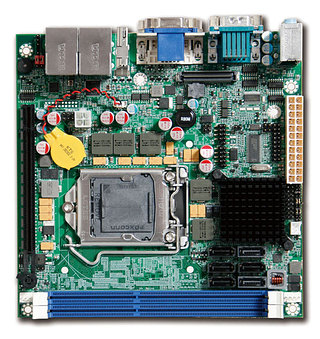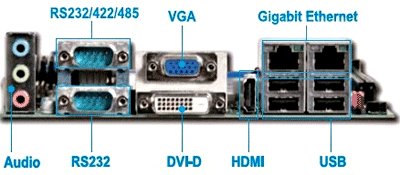Mini-ITX board has quad-core Xeon, RAID support
Aug 11, 2011 — by LinuxDevices Staff — from the LinuxDevices Archive — 2 viewsPortwell announced a Mini-ITX board that includes RAID support and Intel's Xeon E3-1225 processor. The WADE-8011 has six SATA ports (four 3Gb/sec. and two 6Gb/sec.), three video outputs (HDMI, DVI-D, and VGA), eight USB 2.0 ports, plus both PCI Express x16 and PCI Express x1 expansion slots, the company says.
Portwell would have you believe its latest Mini-ITX board is suitable for just about anything. OK, that's a paraphrase: More specifically, the company claims it's "ideal for network security, storage server, point of sale, lottery, medical, gaming, high-resolution digital signage, surveillance security monitoring, and kiosk applications."
Mock we might, but the WADE-8011 should be appropriate for most tasks except those that are power-constrained. Portwell doesn't cite consumption figures, but the Xeon E3-1225 used by the board has a 95 Watt-TDP, according to Intel. (Other specs for the CPU include quad cores, a 3.1GHz clock speed, and a 3.4GHz TurboBoost frequency.)

Portwell's WADE-8011
The Xeon CPU is part of Intel's "micro server" range, to which the chipmaker added as recently as April (with the Xeon E3-1220L, which has a 20-Watt TDP, and the Xeon E3-1260L, which has a 45-Watt TDP). The CPUs are "Sandy Bridge" variants that can work with error-correcting memory and employ Intel's RAID-ready C206 I/O controller.
Portwell used the Xeon E3/C206 combo already in the CAR-4010 network appliance it released in April. That device accepted up to 16GB of DDR3 memory via four DIMM slots, whereas the new WADE-8011 Mini-ITX board takes only 8GB in two slots.
In other respects, however, the WADE-8011 is more well-endowed. For example, the CAR-4010 was designed just to be operated via a serial console, bypassing the CPU's built-in graphics. The present board, on the other hand, has three video outputs: a VGA port that supports resolutions up to 2048 x 1536 pixels, a DVI-D port that supports up to 1920 x 1200, and an HDMI port that also supports up to 1920 x 1200, according to Portwell.

Ports on Portwell's WADE-8011
Other ports on the board's coastline (above) include four USB 2.0 connectors, two gigabit Ethernet ports, two serial ports (one RS232, one RS232/422/485), and audio I/O (mic in, line in, line out). Internally, there are headers for four more USB 2.0 ports, plus six SATA ports (four 3Gb/sec. and two 6Gb/sec.) that allow connected drives to be configured in RAID 0, 1, 5, or 10 arrays, according to Portwell.
The 6.7 by 6.7-inch WADE-8011 also has a PCI Express x16 slot as well as a PCI Express x1 connector, Portwell says. The board includes onboard programmable 16-bit digital I/O, the company adds.
Specifications listed by Portwell for the WADE-8011 include:
- Processor — Intel Xeon E3-1225 (quad cores, 3.1GHz clock speed, 3.4GHz TurboBoost frequency)
- Chipset — Intel C206
- Memory — up to 8GB of DDR3 ECC or non-ECC RAM via two DIMM slots
- Storage — includes 4 3Gb/sec. SATA ports and 2 6Gb/sec. SATA ports
- Other expansion:
- 1 x PCI Express x16 slot
- 1 x PCI Express x1 slot
- Networking — 2 x gigabit Ethernet ports
- Other I/O:
- 16-bit digital I/O
- 8 x USB 2.0 ports (4 external, 4 internal)
- VGA
- DVI-D
- HDMI
- 2 x serial (1 x RS232, 1 x RS232/422/485)
- audio — mic in, line in, line out
- Power — n/s, but apparently uses standard ATX power supply
- Operating range — 32 to 140 deg. F
- Dimensions — 6.7 x 6.7 inches
Further information
Portwell did not detail pricing, availability, or operating system support for the WADE-8011. More information may be found on the WADE-8011 product page.
Jonathan Angel can be reached at [email protected] and followed at www.twitter.com/gadgetsense.
This article was originally published on LinuxDevices.com and has been donated to the open source community by QuinStreet Inc. Please visit LinuxToday.com for up-to-date news and articles about Linux and open source.